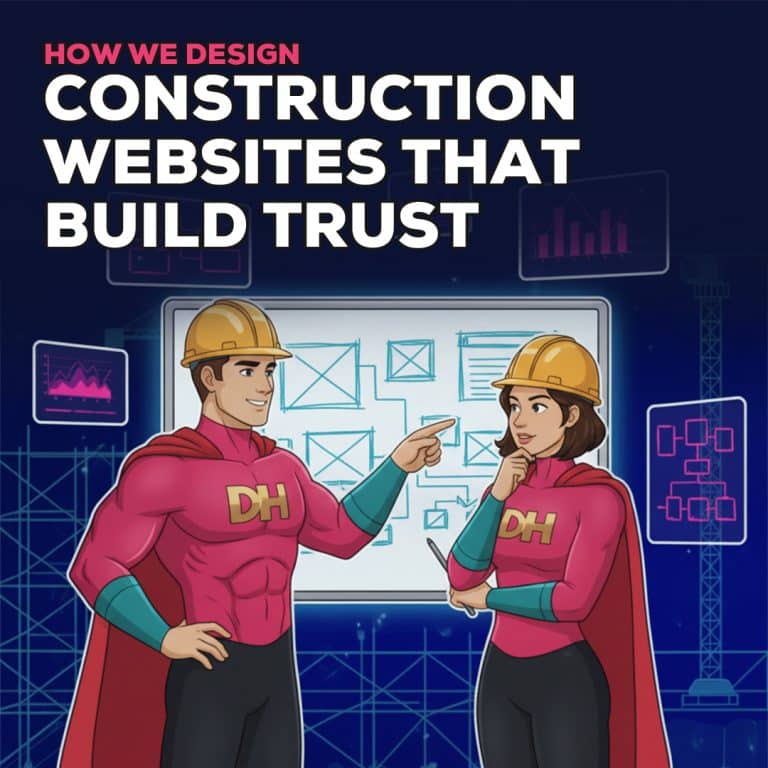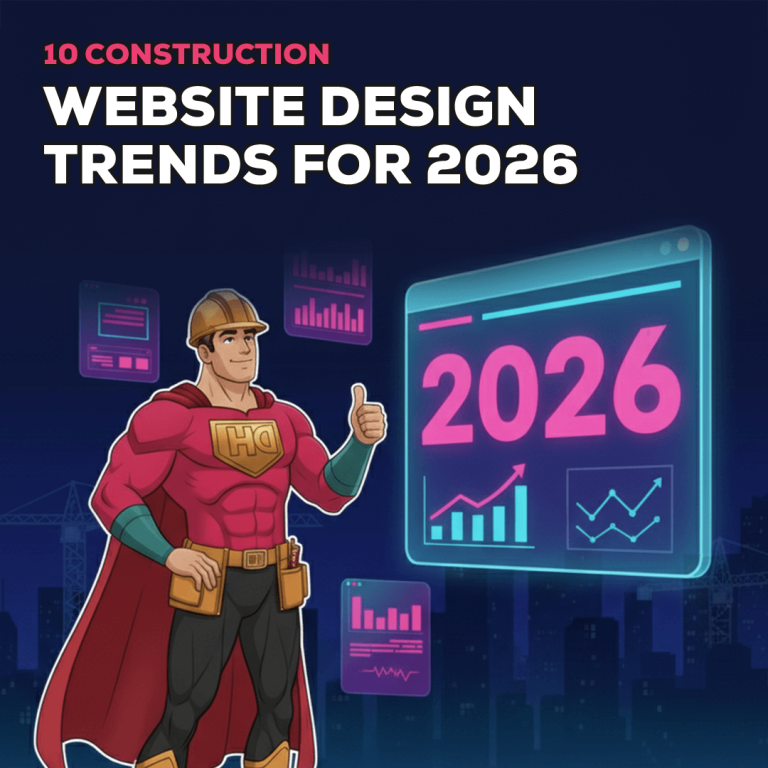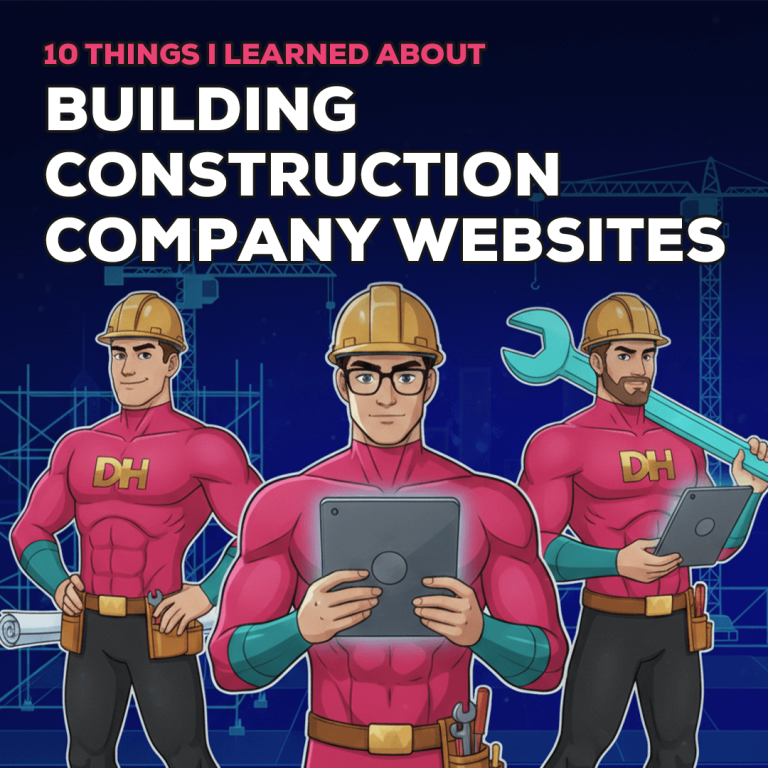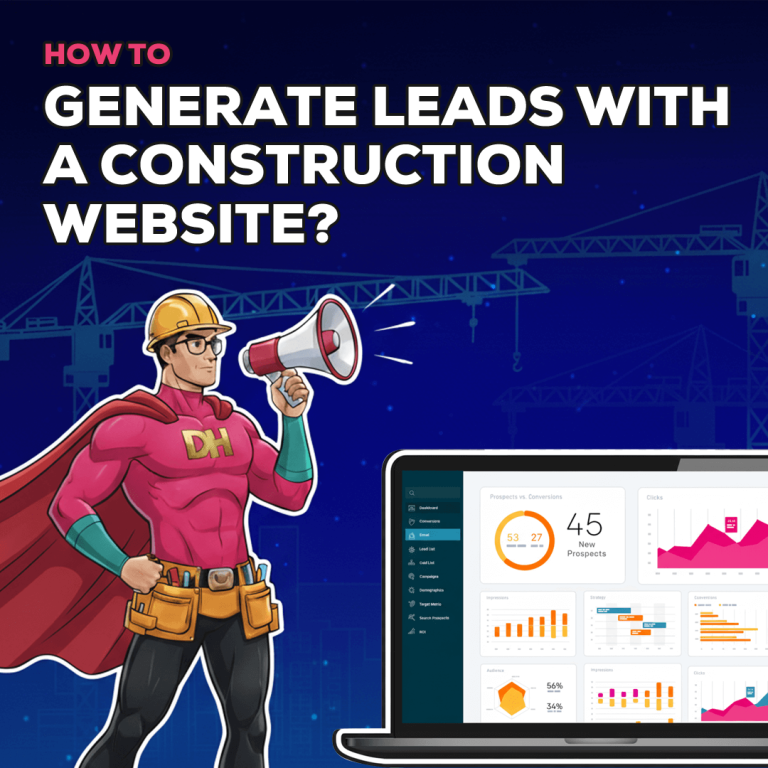A construction company’s website isn’t just a digital brochure – it’s a powerful business tool. With homeowners and commercial clients alike turning to the web to research services and vet contractors, a strong, user-friendly, and informative website can set a construction business apart from the competition. In today’s highly competitive environment, your website needs to do more than look good – it must perform.
In this comprehensive guide, we’ll break down the essential features that every construction company website should have in 2025, explain why each one matters, and provide practical insights on how to implement them effectively.
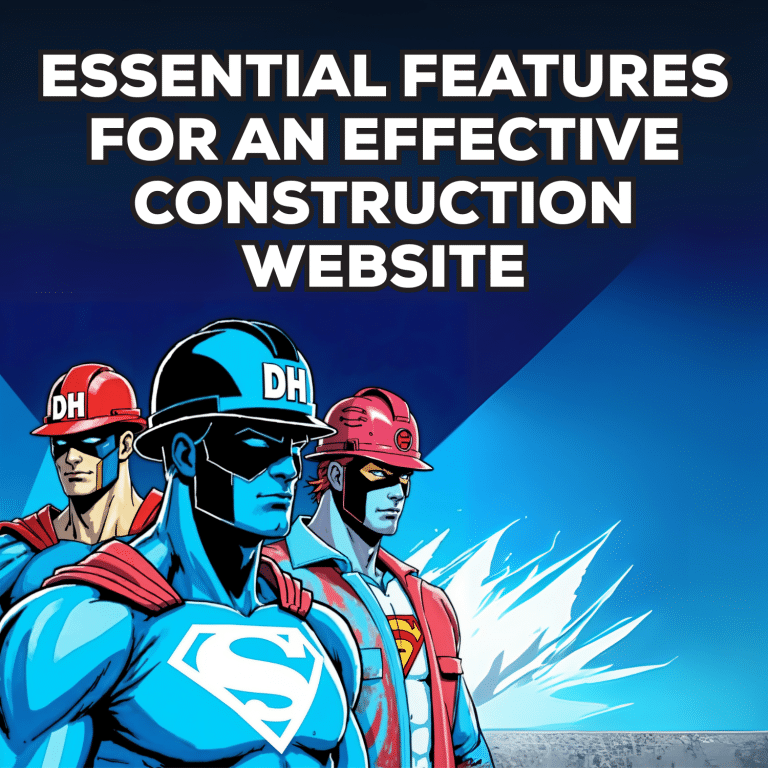
Homepage Elements That Build Trust
Your homepage is often your business’s first and most important opportunity to make a lasting impression. In just a few seconds, visitors decide whether to stay or leave, and that decision is largely influenced by how trustworthy and professional your site appears. For construction companies and other service-based businesses, where reputation and reliability are essential, trust-building homepage elements are critical.
A well-crafted homepage should clearly communicate who you are, what you do, and why a visitor should choose you over other options. It should also guide them toward taking the next logical step, whether that’s requesting a quote, making a phone call, or viewing your portfolio. Your homepage is more than a visual introduction. It needs to work strategically to establish credibility and create a sense of connection.
Key Elements to Build Trust on Your Homepage
Clear Value Proposition
Your headline should immediately state what you offer, who your service is for, and how you stand out. Keep it specific, benefit-driven, and free from jargon. Avoid vague phrases. Clarity inspires confidence. For example, a strong value proposition might be, “Reliable Roofing for Florida Homes, Backed by 25 Years of Local Experience.”
Hero Image or Video
Use high-resolution visuals that reflect your real projects and team. This might include before-and-after photos, on-site action shots, or a brief video featuring your staff or satisfied clients. Avoid generic stock photography whenever possible. Strong visuals can quickly convey professionalism and authenticity.
Call to Action (CTA)
Make your primary action obvious and engaging. Prominent buttons such as “Get a Free Quote,” “Schedule a Consultation,” or “Browse Our Projects” should be placed above the fold and repeated throughout the page. Use action-oriented language that emphasizes value to the visitor.
Trust Signals
Social proof plays a key role in establishing credibility. Include badges from professional organizations, proof of insurance, and certifications such as BBB accreditation or Chamber of Commerce membership. Customer testimonials, star ratings, and industry awards are also powerful. If possible, include testimonials with names, photos, or video to add authenticity.
Quick Overview of Services
Give users a clear summary of your main services right on the homepage. Include brief descriptions along with links to deeper pages for those who want to explore further. This helps visitors quickly confirm whether you offer the solutions they need and improves your SEO structure.
Best Practices for a High-Converting, Trustworthy Homepage
Fast Load Time
Ensure your homepage loads in under 3 seconds. A slow site creates a poor first impression and causes many users to leave before they even see your message.
Trust Within the First Scroll
Display trust elements, such as reviews or certifications, within the first screen view. This helps visitors feel confident in your credibility without having to scroll too far.
Directional Design
Use arrows, contrasting buttons, visual cues, or layout spacing to guide your visitor’s eye toward important areas. Help them navigate toward the next step naturally by creating a visual path.
A great-looking homepage is only part of the equation. It also needs to act as a trust-building tool that communicates reliability, answers key questions, and drives action. Every element should work together to reinforce your brand’s professionalism and capability. When designed with trust in mind, your homepage can become a powerful business asset that helps convert visitors into loyal clients.
Must-Have Pages for Contractors and Tradesmen
While your homepage sets the tone, a strong website structure is what keeps potential clients engaged and builds long-term credibility. For contractors and tradesmen, a clear and well-organized website isn’t just about aesthetics. It plays a critical role in educating prospects, establishing trust, and improving your visibility in search engines. Whether you’re a roofer, plumber, or general contractor, the following essential pages help convert browsers into buyers.
Each of these pages should be designed with the user in mind. Think clear layouts, high-quality visuals, fast loading speed, and content that speaks directly to your local audience. Including location-specific keywords and service information also helps boost local SEO, which is especially important for trades professionals.
About Page
Your About page is more than a company bio. It’s your chance to make a human connection. Share your company’s history, values, and what motivates you to serve your community. This is the place to show your personality and professionalism. Introduce your team with names, photos, and brief bios so clients know who they’ll be working with. Don’t forget to include your credentials, licenses, insurance coverage, and safety certifications. These elements build trust and reassure customers that you’re qualified and reliable. Also, reinforce your geographic service area to help search engines match your site to local queries.
Services Page
Rather than listing everything on one long page, create individual subpages for each major service you offer. For example, separate pages for roofing, electrical, home additions, or remodeling allow you to target specific keywords and provide more detailed information. Use a layout that’s easy to scan. Include icons, bulleted benefits, short paragraphs, and headlines that answer common questions. Adding FAQs for each service improves SEO and helps address objections upfront. The more detailed and helpful these pages are, the more they’ll support your authority and visibility.
Projects or Portfolio Page
Your portfolio is one of the most effective tools for winning trust. Showcasing your completed projects helps prospects visualize what you’re capable of delivering. Use a sortable gallery that allows users to filter by service type, project size, or location. Describe each project with a brief summary of the scope, timeline, materials used, and any unique challenges solved. High-impact visuals like before-and-after sliders, drone footage, or video walk-throughs can elevate the page and make your work stand out. If you can, include customer quotes or satisfaction notes for extra credibility.
Testimonials or Reviews Page
Social proof is powerful. A dedicated testimonials page gives you a space to highlight your happiest clients. Use real names and headshots when available, or even video testimonials for a more authentic touch. Quote cards with standout lines can be highlighted visually, while embedded feeds from platforms like Google or Yelp provide fresh, trusted content. Encouraging clients to submit photos of finished projects or provide reviews directly from your site can also improve engagement and credibility.
Contact Page
The goal of your Contact page is to make it as easy as possible for potential customers to reach out. Include a clean, mobile-friendly contact form with only essential fields (ideally between three and five). Provide multiple contact options, such as phone number, email, and a “request a call” button that appears on mobile devices. Embed a Google Map to show your physical location and include a list of cities or regions you serve. Don’t forget to add your business hours so customers know when to expect a response.
A well-structured website is one of the most valuable marketing tools for contractors and tradesmen. These five pages, when built with care and optimized for both users and search engines, can significantly improve your chances of being found online, booked for projects, and trusted by your community. Investing in these core pages not only enhances the user experience but also positions your business as a local leader in your trade.
UX and Mobile Essentials for Contractor Websites
A great website does more than just look good. It works seamlessly for your visitors. User Experience (UX) design ensures that people can easily find what they need, understand your services, and take meaningful action, whether that means filling out a form, calling your office, or browsing your portfolio. This is especially important for contractors, where most users are on the move and browsing from smartphones or tablets.
More than 65 percent of all web traffic now comes from mobile devices. That means your website must not only display correctly on smaller screens but also offer fast performance and simple, thumb-friendly navigation. Good UX and mobile optimization go hand in hand, making your site more effective at turning visitors into leads.
Mobile Optimization
Design your site with a mobile-first approach. This means starting with the smallest screen in mind and scaling up, rather than the other way around. Ensure all buttons are large enough to tap comfortably with a thumb. Avoid clutter and make sure each page loads quickly by using compressed images and minimal external scripts. Mobile visitors are impatient, so every second counts.
Navigation and Layout
Keep your menu simple and intuitive. Stick to five to seven main items in the navigation, and use a sticky header so it remains accessible as users scroll. Add icons to key navigation links to improve clarity. Highlight important elements like your service areas, core offerings, and customer testimonials across every major page. Consistency in layout helps build familiarity, and familiarity builds trust.
Forms and Click Actions
Forms should be quick to complete. Use conditional logic so that the form adapts to the user’s input, showing only relevant fields. Keep form fields minimal and only request essential information needed to begin a conversation. Offer multiple ways to take action, such as clickable phone numbers, contact buttons, and floating widgets. These small details improve engagement and remove friction from the user journey.
Accessibility Tips
An accessible website helps you reach a wider audience and improves your overall usability. Make sure text has proper contrast against background colors and that font sizes are readable on all devices. Add descriptive alt text to every image so screen readers can interpret your content. Avoid hiding important content behind animations or pop-ups that don’t work well on mobile.
If your site is hard to use, people will leave. But if it’s smooth, fast, and mobile-friendly, visitors will be more likely to trust your business and take the next step. Regularly test your website on different devices and browsers to catch issues early. By focusing on usability and mobile optimization, your site becomes a better sales tool that helps you stand out in a competitive local market.
Lead Generation Features
Your website should function like a 24/7 sales rep, capturing interest and moving visitors toward becoming clients.
Effective CTAs
- Create urgency with CTAs like “Book Before Dates Fill Up” or “Get Your Free Quote Today.”
- Add sticky CTA bars on mobile and desktop.
- Use contrasting colors for buttons to make them stand out.
Forms That Convert
- Offer dropdowns for services, budget ranges, or desired timelines.
- Use conditional fields to shorten form length dynamically.
- Embed forms within project galleries or testimonials for contextual engagement.
Lead Magnets
- Provide downloadable resources: “Kitchen Remodel Cost Guide,” “Pre-Construction Checklist,” or “Project Planning Template.”
- Use pop-ups with exit intent or scroll triggers to offer gated content.
Integrations
- Sync leads to a CRM like HubSpot, Zoho, or Mailchimp.
- Use retargeting pixels (Google, Meta) to remarket to site visitors.
- Integrate live chat or AI chatbots to answer FAQs instantly.
The more ways you provide for clients to connect and convert, the more opportunities you’ll have to win new business.
SEO for Construction Businesses
Even the most impressive website won’t help your business if no one can find it. That’s where Search Engine Optimization (SEO) comes in. SEO ensures your website ranks well on Google and reaches people who are actively searching for the services you offer. For construction companies and trades professionals, investing in a solid SEO strategy can lead to more traffic, more leads, and better-quality clients.
But SEO isn’t just about stuffing keywords into pages. It involves a combination of technical setup, local relevance, valuable content, and ongoing performance tracking. A smart SEO plan makes your site easier to find and more useful to those who visit.
On-Page SEO
On-page SEO helps search engines understand the content of each page on your site. Start by using local keywords that include both your services and location. For example, phrases like “basement renovation contractor in Toronto”, “web designer for construction companies“, or “roof repair services in Austin” are more likely to attract local traffic.
Add schema markup to your pages so Google can display rich snippets such as star ratings, FAQs, and business information directly in search results.
Use internal linking between related service pages and blog posts to help both users and search engines navigate your site more effectively. This also spreads authority across your domain, which can boost rankings.
Local SEO
Construction businesses thrive on local clients, so optimizing for local search is crucial. Claim and optimize your Google Business Profile, including high-quality images, detailed descriptions, and regular posts. List your service areas and keep your operating hours up to date.
Make sure your business information is consistent across all directories like Yelp, Houzz, Angie’s List, and local trade associations. Encourage satisfied customers to leave reviews, and always respond publicly to each one. This not only shows good customer service but also improves visibility in local results.
Blog Content
An active blog helps establish your authority while improving SEO. Write about seasonal topics that align with your services, such as “Top Summer Renovation Projects” or “How to Prepare Your Home for Winter Storms.”
Focus on solving customer pain points. Topics like “How to Budget for a Home Extension” or “Common Roofing Mistakes to Avoid” provide helpful, shareable information. Enhance your posts with videos, infographics, or photo galleries to keep visitors engaged and reduce bounce rates.
Analytics and Monitoring
SEO isn’t a one-time task. You need to track and improve your performance over time. Use Google Analytics 4 (GA4) to monitor which pages generate the most leads, what devices your visitors use, and where your traffic is coming from.
Set up event tracking to measure actions like form submissions, click-to-call buttons, or video plays. These insights help you refine your site for better results. Consider A/B testing different layouts, call-to-action (CTA) buttons, or lead magnet placements to see what converts best. Even small changes can significantly improve performance.
SEO is not just a technical task. It’s a long-term growth strategy that connects you with the right people at the right time. By investing in local search optimization, publishing useful content, and tracking your site’s performance, your construction business can attract more leads and stand out in a competitive market. The more you understand what works, the more your website will evolve into a true business asset.
Is your construction website missing these conversion-boosting features?
A high-performing construction website blends smart design with strategic features. When done right, your website becomes the foundation of your online marketing, one that works day and night to attract, inform, and convert.
Combine these features for an effective construction company website.
From compelling homepage design to detailed service pages, mobile-first UX, strong CTAs, and powerful SEO, every element plays a role in building trust and winning new projects.
Ready to upgrade your construction company website? Contact Design Hero today to get a custom quote, tailored strategy, and high-converting web design that gets results.
View Our Construction Website Case Studies
Frequently Asked Questions
The best features include contact forms, project galleries, testimonials, clear service area info, mobile responsiveness, and strong CTAs.
Focus on UX best practices, mobile optimization, clear calls to action, and showcasing past work to build trust and drive leads.
Most users browse on mobile. A responsive design ensures better user experience, lower bounce rates, and higher conversion potential.
Absolutely. Testimonials build trust and provide social proof that encourages potential clients to contact you.
Use clean URLs, meta data, fast load speeds, local service pages, and structured data to enhance visibility in search engines.
About the author

Nicholas Robb, Founder
The original Design Hero founder, solopreneur and marketing expert; Nick will help you supercharge your business success with a broad skill-set spanning a range of digital marketing fields.
If you want help growing your business


